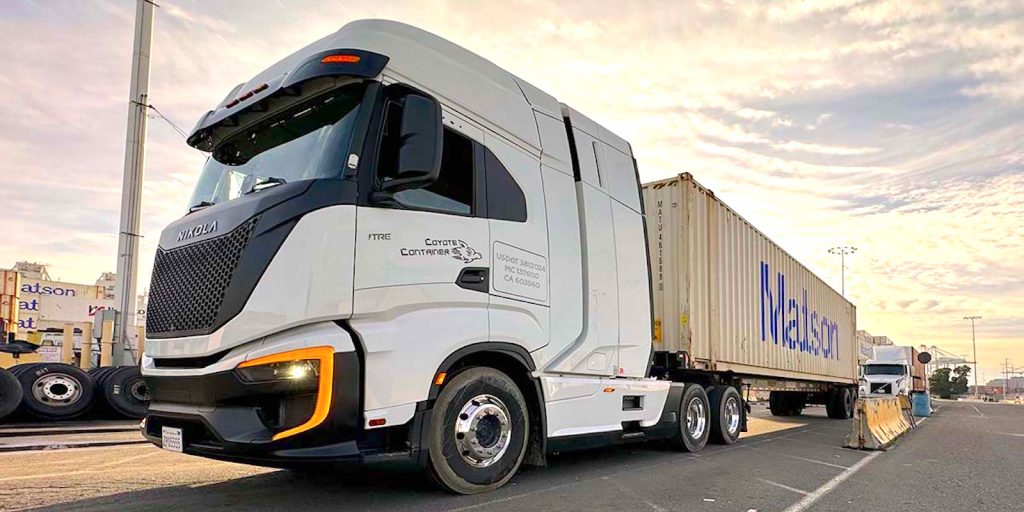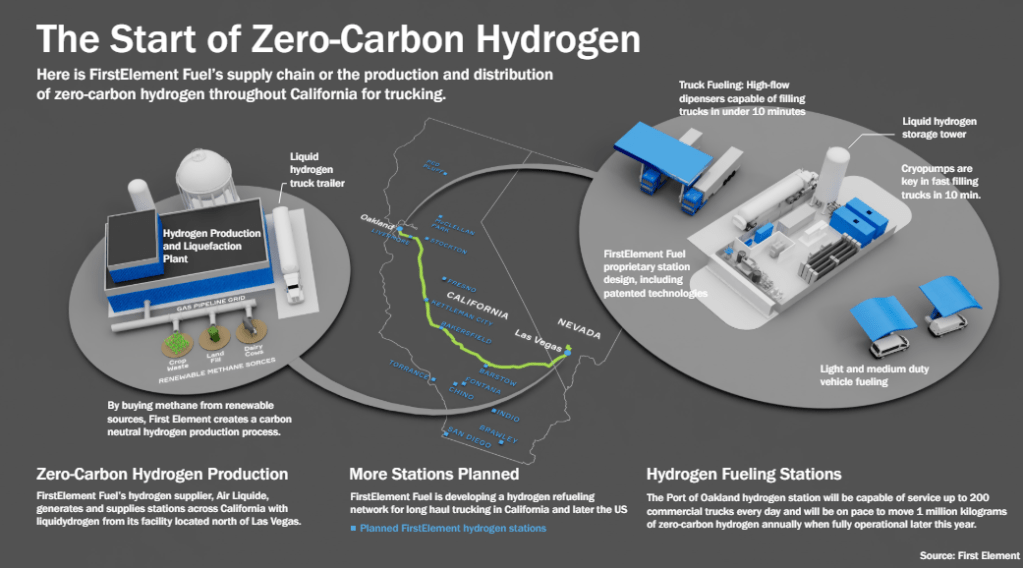
FirstElement Fuels has opened the world’s first large-scale hydrogen fueling station for heavy-duty commercial trucks just outside the Port of Oakland.
FirstElement is calling their new filling station, which opened to the public this week for tours and demonstrations, the first of its kind. Located near the Port of Oakland, the company claims its hydrogen pumps can “fill” a truck’s hydrogen tanks in as little as ten minutes, which works out (in their math) to as many as 200 trucks per day.
As for customers, the company says there are 30 Hyundai Xcient semi trucks using the fueling station currently, as well as a number of Nikola hydrogen fuel-cell-powered trucks.
A ceremony to mark the station’s opening was held Tuesday, and was attended by state officials including Liane Randolph, chair of the California Air Resources Board (CARB) and Tyson Eckerle, clean transportation advisor for Gov. Gavin Newsom’s business development office. Primary funding for the Oakland station was provided by CARB and the California Energy Commission.
Eckerle notes that the US federal government is handing out $8 billion to jump-start what it calls the “hydrogen economy,” and expects sufficient funding to build up to 60 more hydrogen truck stations like this one in California – which would, theoretically, be enough to serve 5,000 trucks and 1,000 buses.
All well and good, but …
What if it’s already too late for hydrogen?

MAN Trucks CEO, Alexander Vlaskamp, said it best when he said that it was “impossible” for hydrogen to effectively compete with BEVs.
He’s right – on a level playing field, there is absolutely no reason to believe hydrogen has any kind of future. But we don’t operate on a level playing field, and comments like Eckerle’s, along with an $8 billion federal budget and a number of supposedly genuine industry experts touting its usefulness as a fuel, mean we have to take hydrogen seriously (at least, for now).
Even so, it seems like the tide of public opinion is already starting to turn against hydrogen. Outlets that may never have questioned a manufacturer’s claims about a hydrogen-fueled vehicle a few years ago now seem more than willing to call those claims out. Here’s just one example:
Producing hydrogen itself can be very dirty. Most hydrogen produced today requires methane, which is a fossil fuel and a strong greenhouse gas contributor. The industry is working on production alternatives, including carbon capture and storage from the burning of methane, or quitting methane altogether to make green hydrogen, using an electrolyzer to split water’s hydrogen and oxygen.
Both alternatives are prohibitively expensive without government subsidies.
RUSS MITCHELL, AOL/Los Angeles TIMES.
So far, it’s not clear that FirstElement’s claims about either the sustainability of its hydrogen or the practicality of its filling station will convince many battery electric absolutists.
Take the company’s hydrogen production process as an example. FirstElement says that its supplier, Air Liquide in Las Vegas, uses natural gas as “feedstock” for its hydrogen. It buys biogas to blend with natural gas in order to create hydrogen – and that, because the gas used is more than 60% renewable, the hydrogen qualifies as “green.”
FirstElement hydrogen production

Additionally, the claim of 10 minute fast fills should come with an asterisk or two. That’s because FirstGreen is using new “cryopump” technology from Bosch Rexroth to allow for filling at 900 bar (15,000 psi). While that seems like more enough to push 100 kg into a tank in about ten minutes, cryogenically cooling hydrogen is an energy intensive technology that requires a lot of electricity to function properly. Electricity that it says will come from the stored hydrogen.
In fairness, however, Bosch has some ideas here to help station owners maximize the usefulness of all that electricity.
“Cold is like gold,” says Dave Hull, regional vice-president, Bosch Rexroth. “You’ve got all this cold energy. All my career I worked to get rid of heat. You can take that energy and run a whole station’s refrigerators for Rock Star energy drinks, or air conditioning. Bosh has a whole division of heat pumps and building technologies.”
Whether or not that added efficiency adds up to actual energy and cost savings, rather than a lifeline for the gas industry and tier 1 auto suppliers like Bosch however, remains to be seen. Meanwhile, hydrogen costs continue to rise.
Platts last assessed California’s retail hydrogen price at $33.48/kg Jan. 4, 2023, which is the weighted average hydrogen price offered at retail fueling stations across the state. The price has risen 112% from when Platts began the assessment in September 2021, according to S&P Global Commodity Insights data.
SP GLOBAL
Despite the high cost of hydrogen (“green” hydrogen is more expensive, still), Shane Stephens, one of FirstElement’s founders and its chief development officer, remains undeterred.
Top comment by David Long
Here's the problem with hydrogen - before you get to all the problems (energy losses) with transportation and storage.
It takes 50kWh of electricity (hopefully green sourced) to make 1 kg of H2 from electrolysis.
1 kg of H2 will power a Mirai for about 50-60 miles.
50 kWh of electricity will power my Model 3 for over 200 miles.
That's the bottom line before you get to all the other problems, challenges and inefficiencies of hydrogen. I can see use cases for hydrogen, but powering something on our roads isn't it.
“We, at FirstElement Fuels, have a lot of confidence the market is coming,” says Stephens. “We see the regulations on the horizon, the OEMs and fleet owners are going to have to respond to that, especially when it comes to goods movement, and hydrogen and fuel cells are the best – if not only – solution that will work for many of those use cases.”
Electrek’s Take
As a light vehicle fuel – despite the efforts of Hyundai, Toyota, and (more recently) Honda – things aren’t going well for hydrogen. As a fuel for massive semi trucks and even bigger heavy equipment, however, it might stand a chance against current battery technology.
But battery tech isn’t stagnant, and lighter, better, faster charging battery news that used to come every year, and then every month, now seems to be coming every week – and I’d argue that you’d be foolish to assume batteries that are twice as energy dense at half the weight won’t be here well ahead of California’s 2035 ICE ban.
But that’s just me. You guys are smart. Head on down to the comments and let us know what you think.
FTC: We use income earning auto affiliate links. More.






Comments